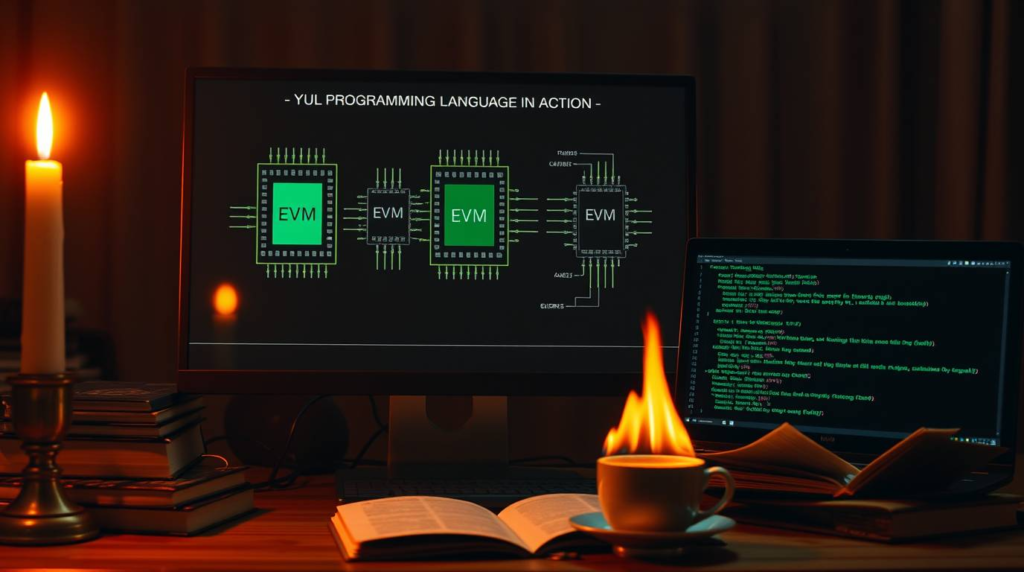Yul vs Solidity : Ethereum’s programming ecosystem is vast and continuously evolving, giving developers tools to create decentralized applications and smart contracts. Two key components of this ecosystem are Yul and Solidity, both of which are essential for Ethereum development. While Solidity is widely known and used, Yul often stays in the shadows, despite its efficiency and optimization capabilities. In this article, we’ll explore the differences between Yul and Solidity, their use cases, and how you can leverage them to build robust applications.
Table of Contents
What Is Solidity?

Solidity is a high-level programming language designed specifically for developing Ethereum smart contracts. It offers a syntax similar to JavaScript, making it approachable for developers transitioning from traditional programming.
Why Use Solidity?
- Ease of Use: With detailed Solidity tutorials and comprehensive documentation, learning and implementing Solidity is straightforward for most developers.
- Community Support: The Ethereum developer community provides extensive resources, forums, and discussions to support Solidity developers.
- High-Level Abstraction: Solidity abstracts the complexities of Ethereum’s EVM (Ethereum Virtual Machine), letting developers focus on logic instead of low-level details.
What Is Yul?

On the other hand, Yul is an intermediate-level, low-level language designed to interact closely with the EVM. It is often used for optimizing smart contracts and working on advanced projects requiring direct interaction with Ethereum’s bytecode.
Key Features of Yul
- Lightweight Syntax: Yul is much simpler than Solidity, as it avoids unnecessary abstractions.
- Cross-Platform Compatibility: Yul supports multiple backend targets, making it versatile for both EVM and eWASM (Ethereum WebAssembly).
- Optimization-Friendly: Yul allows developers to write gas-efficient code by providing more control over low-level operations.
Yul vs Solidity: The Core Differences
| Feature | Solidity | Yul |
|---|---|---|
| Abstraction Level | High-level language with JavaScript-like syntax | Low-level intermediate language |
| Use Case | Writing smart contracts | Optimizing contracts and low-level tasks |
| Learning Curve | Easier due to extensive resources | Steeper due to less abstraction |
| Gas Optimization | Limited optimization | Highly gas-efficient |
| Documentation | Comprehensive (Solidity Tutorial) | Less extensive (Yul Documentation) |
When to Use Yul
If you’re developing a smart contract and need high performance, Yul is a great choice. Developers use Yul in scenarios where:
- Gas Optimization is Crucial: For contracts with heavy computational requirements, Yul’s assembly-like capabilities can reduce costs.
- Advanced Development Needs: Writing custom libraries or working directly with bytecode.
- Debugging and Testing: Since Yul interacts closely with the EVM, it’s perfect for testing low-level behavior.
When to Use Solidity
For most developers, Solidity is the go-to language for Ethereum development. It’s ideal for:
- Standard Smart Contracts: Simple to moderately complex applications.
- Quick Prototyping: Solidity’s syntax and tools allow for faster development cycles.
- Wider Adoption: If you need community support, tools, and pre-written libraries, Solidity is the clear choice.
Yul Programming Language in Action

Let’s dive into a simple Yul programming language example:
{
let x := 1
let y := 2
let sum := add(x, y)
return(sum, 32)
}Here, you can see how straightforward Yul is for performing low-level operations like addition and memory allocation. Compare this to the verbose nature of Solidity, and you’ll appreciate Yul’s simplicity for optimization tasks.
Yul Assembly and How to Use It
Yul is essentially an assembly-like language. Developers often use Yul assembly Ethereum features for writing efficient code. Here’s how you can get started:
- Understand Memory Management: Yul gives direct control over memory, storage, and stack.
- Leverage Existing Tools: Use Yul documentation and community examples to understand best practices.
- Iterative Testing: Test your Yul code thoroughly to avoid errors that could lead to vulnerabilities or inefficiencies.
Pros and Cons of Yul vs Solidity

Advantages of Solidity:
- User-friendly for new developers.
- Rich tooling ecosystem (e.g., Remix, Hardhat).
- Strong focus on security features like modifiers and checks.
Advantages of Yul:
- Offers unparalleled gas efficiency.
- Provides more control over contract behavior.
- Ideal for custom and advanced use cases.
Limitations of Solidity:
- Less efficient for gas optimization compared to Yul.
- High-level abstraction can limit fine-tuning.
Limitations of Yul:
- Steep learning curve.
- Limited Yul programming language tutorials and resources compared to Solidity.
Yul vs Solidity Ethereum Reddit Discussions
If you explore developer forums like Reddit, you’ll notice debates about Yul vs Solidity often focus on specific use cases. For instance, many developers recommend starting with Solidity for ease of development and switching to Yul only when optimization is critical.
FAQs: Yul and Solidity
What is Yul assembly, and how does it differ from Solidity?
Yul assembly is a low-level intermediate language optimized for the EVM. It’s used for writing gas-efficient code, while Solidity is a high-level language for building smart contracts with ease.
How can I learn Yul programming language?
Start with the Yul documentation and look for Yul programming language tutorials available in the Ethereum community. Experiment with examples to understand its syntax and use cases.
Is Yul better than Solidity?
It depends on the use case. For gas optimization and low-level control, Yul excels. For general development, Solidity is more accessible and versatile.
Can I use Yul and Solidity together?
Yes! Developers often write the main logic in Solidity and optimize specific functions in Yul for better performance.
Conclusion
Choosing between Yul and Solidity depends on your project’s requirements. Solidity offers simplicity and a large ecosystem, while Yul provides performance and optimization. As a developer, understanding both languages gives you the flexibility to build efficient and secure smart contracts.
To master Ethereum development, start with Solidity tutorials and gradually explore Yul programming language examples to deepen your expertise. This dual knowledge will empower you to create scalable, cost-effective, and secure applications on the Ethereum blockchain.


